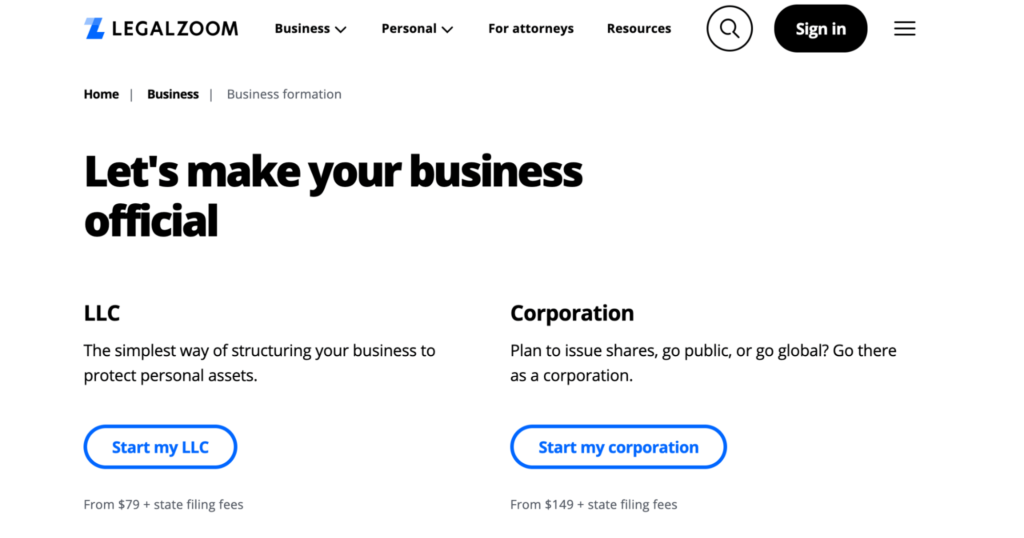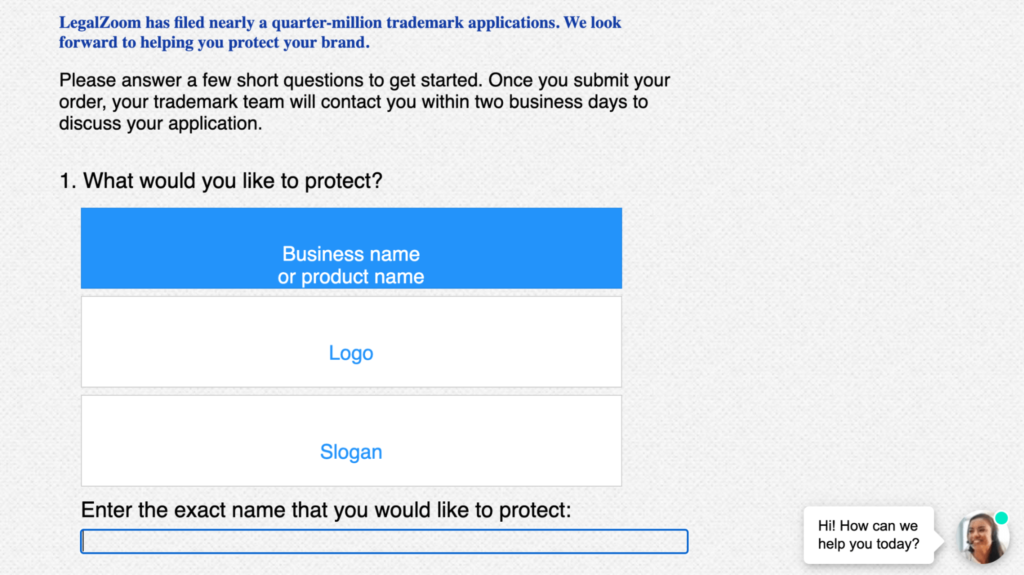Disclosure: This content is reader-supported, which means if you click on some of our links that we may earn a commission.
Coming up with a great business name is a challenge in itself. To legally protect that name, you should consider filing a trademark application.
This guide will explain everything you need to know about how to trademark a business name and the best time to do it.
Why Trademarking a Business Name is Worth It
There are lots of key benefits and advantages of trademarking a business name. By trademarking your name, you’ll have the exclusive rights to use that name nationwide with goods or services associated with your business. An official trademark registered with the United States Patent and Trademark Office (USPTO) has strong protections in federal court.
Trademarking your business name prevents confusion for consumers. It also prevents another business from selling similar products or services using the same name, which could potentially harm your brand’s reputation. For example, if a consumer buys something from another business using the same name as yours, that customer might actually think they’re buying from you.
Registering a trademark for your business name is a crucial step in the big-picture branding process. It can help you create a nationally or internationally recognized name, like Nike, McDonald’s, and Apple.
Trademarked names are appealing to investors as well. So if you want to secure funding and raise capital over time, many investors will require you to obtain a trademark before they invest money into your company.
It’s also worth noting that trademarking a business name isn’t for everyone. If you’re running a small, local operation with no plans to scale, then it’s probably not worth it for you. But if you want to grow and build a brand outside of a single community, then you should definitely consider getting a trademark for your business name.
The Investment Needed to Trademark a Business Name
Registering a trademark for your business name isn’t an overnight process. It takes time, paperwork, and money.
The initial application with the USPTO starts at $250 or $350 per class of goods or services that you’re filing for. Only one mark can be filed on an application. So if you’re registering multiple trademarks, then you’ll need to fill out separate applications and pay separate filing fees for each.
There are additional fees after you’ve submitted the application as well. These range from $100 to $525 and cover things like showing the use of the trademark, requesting an extension of use, filing declarations, and renewals. Expect to pay around $750 or so during the initial process, and it should take about 6-12 months to obtain the trademark after you’ve filed.
It does take a while for the USPTO to review your trademark application, and they may ultimately request additional information or deny your application if there’s an error on your forms. So it’s really important to get this right the first time, ensuring that you register your trademark as soon as possible.
To simplify the trademark process, you can use an online trademark service like LegalZoom. LegalZoom will walk you through the application process, proofread the application, and file everything on your behalf. They also offer attorney-assisted trademark services to help increase your success rate of securing a trademark for your business name.

5 Steps to Trademark a Business Name
Now that you understand the basics of trademarking a business name, it’s time to get one for yourself. While it may seem a bit overwhelming, you can trademark a business name and in just five simple steps.
#1 – Determine the Best Time to Trademark Your Business Name
When is the right time to file a trademark application? Assuming a trademark is actually right for your business, then the answer is immediately.
In most cases, the best time to file a trademark application for your business name is right after you’ve filed paperwork to form your LLC or corporation. By doing this before your business officially launches, it protects the name for commercial use once you’re up and running. Since it can take up to a year or longer to actually get the name trademarked by the USPTO, it’s definitely in your best interest to get an early start.
This is another reason why we recommend LegalZoom for trademarking a business name. In addition to the trademark options offered by this online service provider, LegalZoom is also an excellent option for forming a legal business entity.

Whether you’re launching an LLC or corporation, LegalZoom has you covered. The service has been used to form over two million businesses nationwide, making it the most popular business formation service on the market today.
Once you’ve filed your formation paperwork, you can proceed with your trademark application using the same account. This really simplifies everything for you, as you can get multiple business services under the same roof.
For those of you who have already started a business and haven’t filed a trademark application for your business name yet, that’s okay—don’t panic just yet.
Even if you haven’t officially trademarked your business name, nobody else in your state can use your business name once you’ve formed a legal entity with the secretary of state’s office. Furthermore, common law trademark rights protect names, logos, and phrases that are regularly used for business purposes.
In short, as soon as you use your business name for the sale of goods or services, that name is protected under common law trademark rights. However, this won’t protect your business name nationwide, which is why it’s so important to continue with the trademark process ASAP.
Let’s say another business offering the exact same products as your company decides to trademark your business name with the USPTO. If that business is located in another state outside of your region and they file trademark paperwork before you, then you likely won’t be able to apply for a federal trademark using that same name. Common law rights won’t protect you here, and you could be forced to change your business name if you want to expand and scale to new markets.
#2 – Run a Trademark Search
Now it’s time for you to run a trademark search. This is another reason why it’s crucial to trademark your business name when you’re filing the formation paperwork.
A trademark search will help you identify any potential conflicts before you apply for a trademark. If you file your trademark paperwork without running a search, the application could be rejected if another business is using that name or if someone else filed ahead of you.
So six or eight months from now, you could get a rejection letter and have to start again from scratch. Not only will this cost you time and your initial application fee, but it can be even more costly if you’ve been using that name and now need to think of a new one.
The easiest way to run a trademark search for your business name is with LegalZoom.

This service has been used over 50,000+ times by businesses seeking a trademark and usually takes less than 15 minutes to complete.
The fee for LegalZoom’s trademark search starts at just $199, which is marginal compared to the thousands of dollars it could cost if you apply for a trademark that’s already been registered.
In addition to a federal trademark search with the USPTO, LegalZoom also has packages that cover state trademarks, common law trademarks, and international searches. These options are ideal for those of you who want to scale big down the road. You can identify potential conflicts now while your brand name is still in its infantile stages.
Do not file a trademark application until you’ve run a comprehensive search of your business name.
#3 – File a Trademark Application For Your Business Name
Once you’ve verified that your business name doesn’t already have a trademark, you can go ahead and proceed with the trademark application.
You can apply for a trademark directly through the USPTO website. The online application is great for DIY users, but there are lots of factors to consider here.
Obtaining a trademark from the USPTO isn’t as simple as haphazardly submitting a form and waiting for a reply. You must be meticulous with every aspect of your application, or the trademark could get rejected.
That’s why it’s so much better to use an online trademark service for assistance. LegalZoom’s platform and process are just about as easy as it gets, even for complete beginners.
There’s a DIY trademark service from LegalZoom that starts at $249 and an attorney-lead service starting at $599. All you need to do is answer some questions about your business, and LegalZoom will take care of the rest.

The attorney-assisted service gives you a 94% chance of securing your trademark. If the mark gets rejected, LegalZoom will cover the $599 fee to register a different mark.
This service gives you peace of mind knowing that a lawyer will research the trademark for you and deal with minor speed bumps along the way. You’ll also get a free trademark search for another business name if a LegalZoom attorney thinks there’s a problem with your first one.
#4 – Monitor the Application and Submit Additional Paperwork (If Necessary)
A trademark application is not a “set it and forget it” type of process. It’s common for an attorney from the USPTO to request supplemental information about your trademark.
If you fail to respond to this request by the deadline, your application will be denied, and you’ll need to start over from scratch. This is a hurdle that could potentially cost you the name of your business if someone else files ahead of you during this lapse.
This is another reason why it’s important to have an attorney on your side throughout the trademark registration process.
Examples of additional forms requested by the USPTO include:
- Response forms
- Intent-to-use (ITU) forms
- Post-approval/publication/post-notice of allowance (NOA) amendment forms
- Correspondence and attorney representative forms
- Petition forms
- Miscellaneous forms
- Maintenance and renewal correction forms
- Trial and appeal board forms
There are dozens of forms in these categories, so you need to pay close attention to your application as it moves through the USPTO approval process.
#5 – Defend Your Trademark
The USPTO only issues trademarks and handles renewals. It doesn’t actually enforce trademark violations. So it’s up to you to stop other businesses from using your name.
This is obviously a daunting task, considering the number of businesses in existence across the country and globe.
Using a trademark monitoring service is the easiest way to defend your trademark.

LegalZoom’s trademark monitoring service starts at just $175 per year.
They’ll set up a customized trademark monitoring query for your business name and send you a detailed report every month about the mark. The service includes active monitoring with the USPTO database and pending applications.
LegalZoom’s advanced discovery will even identify trademarks similar to yours, like names that sound similar or names that are off by one or two letters.
Should a potential trademark infringement arise, LegalZoom can put you in touch with an experienced attorney to help you defend your name before things get out of control.
Next Steps
Filing a trademark application for your business name is just the first step to protecting your brand. This type of trademark is solely for the name associated with the goods or services you’re offering, but it doesn’t extend to other aspects of your business.
In addition to your name, you should also trademark your logo. This will help prevent other businesses from using the same logo or a logo that’s confusingly similar to yours. You can take this one step further and file a trademark application for a phrase or slogan as well. LegalZoom can help you with all of these.
It’s also worth noting that a trademark doesn’t protect your products. So if you have an invention or something that’s unique and proprietary associated with your business, you’ll need to get a patent to prevent others from using it.
If you’re being proactive and want to register a business name before actually starting your business, you’ll need to provide supplemental paperwork after your initial application to show that you’re actually using the trademark for a business name. In this scenario, your next step would need to be starting the business.




